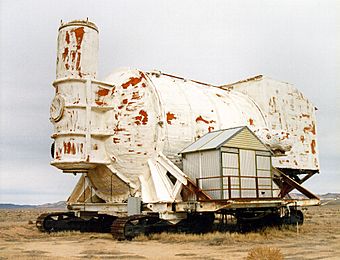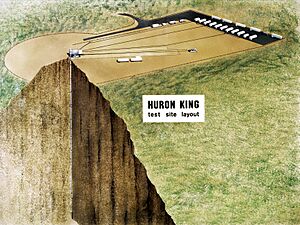Operation Tinderbox facts for kids
Quick facts for kids Tinderbox |
|
|---|---|
 |
|
| Information | |
| Country | United States |
| Period | 1979–1980 |
| Number of tests | 14 |
| Test type | underground shaft |
| Max. yield | 140 kilotonnes of TNT (590 TJ) |
Operation Tinderbox was a series of 14 nuclear tests carried out by the United States between 1979 and 1980. These tests took place deep underground at the Nevada Test Site. They were part of a larger effort to develop and improve nuclear weapons technology. This series came after Operation Quicksilver and before Operation Guardian.
Contents
What Was Operation Tinderbox?
Operation Tinderbox was a group of 14 underground nuclear tests. These tests were done to help scientists and engineers learn more about how nuclear weapons work. They also helped to develop new and better weapons. Each test involved setting off a nuclear device far below the Earth's surface.
Where Did These Tests Happen?
All the tests in Operation Tinderbox happened at the Nevada Test Site (NTS). This site is a large area in Nevada, United States, specifically designed for testing nuclear devices. The tests were done in deep holes, called shafts, drilled into the ground. This method helps to contain the explosion and most of the radioactive material underground.
How Were the Tests Done?
For each test, a nuclear device was lowered into a very deep shaft. Once it was in place, the shaft was sealed up. Then, the device was exploded. Scientists would then study the effects of the explosion. Most of these tests were for "weapons development," meaning they were trying out new designs or improvements for nuclear weapons. Some tests also looked at "weapon effects," which means studying how a nuclear explosion affects different materials or equipment.
Notable Tests in Operation Tinderbox
While there were 14 tests, some had specific goals:
- Azul (December 14, 1979): This test was used to destroy a nuclear device that had been damaged during its placement.
- Tarko (February 28, 1980) and Verdello (July 31, 1980): These tests showed some "venting." This means a small amount of radioactive gas escaped from the ground after the explosion.
- Pyramid (April 16, 1980): This was one of the most powerful tests in the series, with a yield of 89 kilotons. A kiloton is equal to 1,000 tons of TNT.
- Kash (June 12, 1980) and Tafi (July 25, 1980): These were the most powerful tests, each with a yield of 140 kilotons.
- Huron King (June 24, 1980): This test was special because it studied how a nuclear explosion affects equipment. A model of a DSCS satellite was placed on the surface near the test site. After the explosion, the satellite model was moved away from the collapsing ground. You can still see the remains of the test chamber near the crater.
Images for kids



